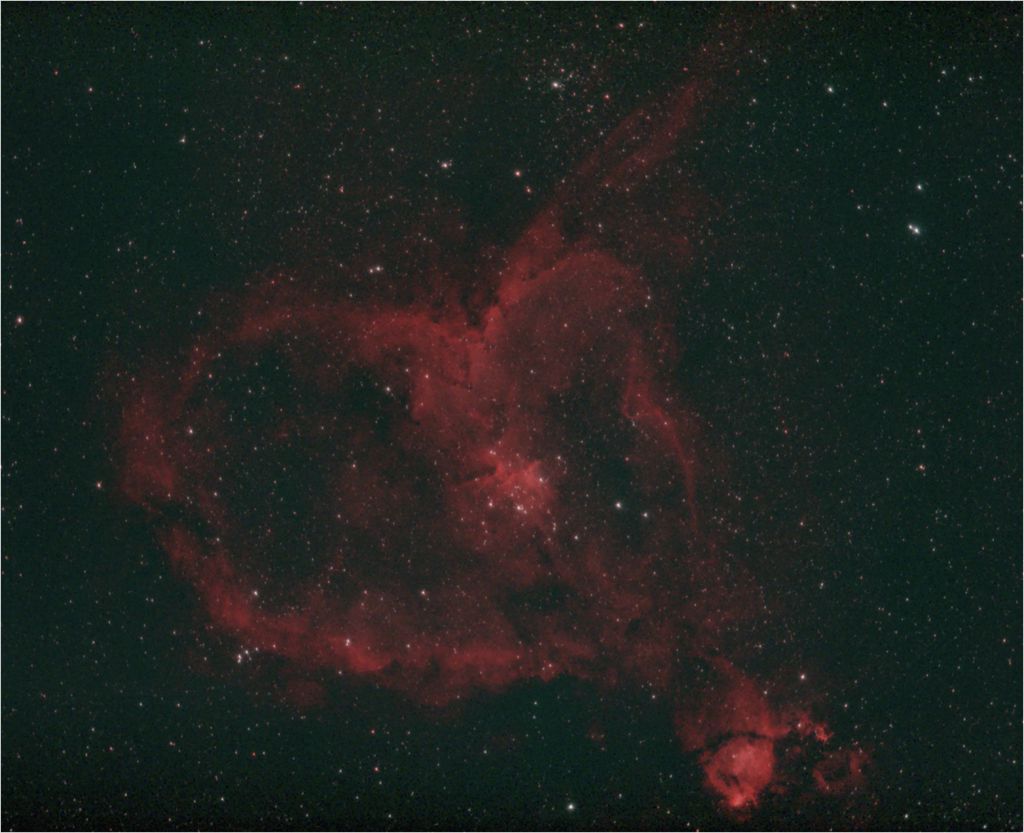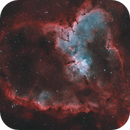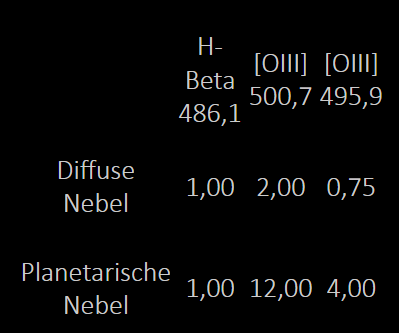Howdy!
I'm wondering how to pull out Oiii data from the Rosette nebula that was acquired with the ZWO 294MC PRO OSC and the ZWO dual band filter. I use APP and/or Affinity for processing. I thought I would have seen something after the the basic run through APP.
[3 hours (240*45"), 60 each flat/bias/dark, fairly bright moon, Canon 100-400 ].
TiA,
Mike
 |
You cannot like this item. Reason: "ANONYMOUS".
You cannot remove your like from this item.
Editing a post is only allowed within 24 hours after creating it.
You cannot Like this post because the topic is closed.
The O(III) signal is at around 501 nm and the H(alpha) signal at around 656 nm
So you find the H(alpha) signal in the red channel and the O(III) signal in the blue and green channel (see e.g. this color-wavelength chart: Wavelength Color Chart ). It's been a while since I did my personal evaluation of APP but for sure it lets you split your OSC image into individual R, G, B channels, which you then can mix according to your own taste.
What makes things a bit complicated is the fact that the H(beta) line at 486 nm is fairly close to the O(III) signal so. Looking at the characteristics of the ZWO Dual Narrowband filter it seems unavoidable that you're catching H(beta) signal too - Regions with strong H(alpha) lines will inevitably also show H(beta) signals.
As a beginner AP I leave it to the more experienced fellow astrobin users to explain how to handle this. In my naive understanding one may get rid of part of the H(beta) signal by subtracting a fraction of the H(alpha) signal. Of course the assumption that the ratio between H(alpha) and H(beta) is constant throughout a widespred nebula is very optimistic (if not outright dumb ...). This is a point where the experts have to take over.
Clear skies
Wolfgang
|
You cannot like this item. Reason: "ANONYMOUS".
You cannot remove your like from this item.
Editing a post is only allowed within 24 hours after creating it.
You cannot Like this post because the topic is closed.
|
The question is why would you want to do that? There is no reason to remove the Hbeta signal embedded into the B channel, even if you could. With very rare exceptions (one being NGC434) the Hbeta is way weaker than OIII (usually an order of magnitude weaker) and hardly work the effort, never mind the pointlessness of the endeavour.
|
You cannot like this item. Reason: "ANONYMOUS".
You cannot remove your like from this item.
Editing a post is only allowed within 24 hours after creating it.
You cannot Like this post because the topic is closed.
In APP run your first integration as normal but in Tab 0 RAW/FITS set Algorithm to "Ha-0iii extract Ha" and run the integration. This will produce a mono image which is your Ha.
Then without removing files or closing APP, change Algorithm to "Ha-Oiii extract Oiii" and run the integration again - it will redo normalization but thats fine. This will produce a second mono image which is your Oiii.
After that you can combine them as HOO using this method to make the Oiii pop https://www.youtube.com/watch?v=5M3zB7-Llhw&list=WL&index=10 Although this uses pixinsight I expect there is a way to do similar in Affinity.
Thats what I did with

IC 1805 The Heart Nebula (HOO)
Within APP you would take the the two mono's into "Combine RGB" tab and combine using the HOO recipe. I had limited success with that but its worth trying.
Info on the APP site states that this will produce better, less noisy Ha/Oii than simply separating channels and using R as Ha and G (or some combination of G&B) as Oiii. I cant confirm that but it certainly gives usable Ha and Oiii images.
HTH
|
You cannot like this item. Reason: "ANONYMOUS".
You cannot remove your like from this item.
Editing a post is only allowed within 24 hours after creating it.
You cannot Like this post because the topic is closed.
andrea tasselli:
The question is why would you want to do that? There is no reason to remove the Hbeta signal embedded into the B channel, even if you could. With very rare exceptions (one being NGC434) the Hbeta is way weaker than OIII (usually an order of magnitude weaker) and hardly work the effort, never mind the pointlessness of the endeavour.
For the question why you want to do that: Maybe because you want to show O(III) and not O(III) + Hb.
For the second part: I would challenge the claim that Hb is always much weaker than O(III). For objects (or regions of a given object) where Ha is very strong and O(III) quite weak, I would be willing to bet that Hb can be ignored easily.
I only have this source (german only, sorry) which deals with visual astronomy to support my claim: Nebelfilter visuell (svenwienstein.de) As a rule of thumb it provides these examples for intensity ratios:

So for planetary nebula you have a point while for diffuse nebula it's more like 1:3 with a significant dependency on a given object as they point out in their article.
It would be interesting to learn about the APP magic for "extract Ha" and "extract Oiii".
Clear skies
Wolfgang
|
You cannot like this item. Reason: "ANONYMOUS".
You cannot remove your like from this item.
Editing a post is only allowed within 24 hours after creating it.
You cannot Like this post because the topic is closed.
It would be interesting to learn about the APP magic for "extract Ha" and "extract Oiii".
I'm sure if you put a question on the APP forum Mabula or one of the Mods will explain it to you.
|
You cannot like this item. Reason: "ANONYMOUS".
You cannot remove your like from this item.
Editing a post is only allowed within 24 hours after creating it.
You cannot Like this post because the topic is closed.
or the question why you want to do that: Maybe because you want to show O(III) and not O(III) + Hb.
For the second part: I would challenge the claim that Hb is always much weaker than O(III). For objects (or regions of a given object) where Ha is very strong and O(III) quite weak, I would be willing to bet that Hb can be ignored easily.
I only have this source (german only, sorry) which deals with visual astronomy to support my claim: Nebelfilter visuell (svenwienstein.de) As a rule of thumb it provides these examples for intensity ratios:
It is a pointless endeavour and to what purpose? It is not like any of this is going to any scientific endeavour, is it? H-beta is important in PNs because gives a metric to estimate ionization temperatures but for emission nebulae I can't see a reason and in fact I can't remember ever having seen it mentioned in Simbad or similar databases. Besides, I explicitly said "with rare exceptions", so yes there are out there a number of them, but not many (and NGC1805 ain't one of them). I would challenge the notion you can estimate photometric quantities by visual means only and then in otherwise unknown manner and extent. I have a H-beta filter and I know for a fact that used to sit most uselessly except when I wanted to go for long integration in PNs. I've tried it before on a number of nebulae and making the usual exceptions the results are meagre.
|
You cannot like this item. Reason: "ANONYMOUS".
You cannot remove your like from this item.
Editing a post is only allowed within 24 hours after creating it.
You cannot Like this post because the topic is closed.
andrea tasselli:
The question is why would you want to do that? There is no reason to remove the Hbeta signal embedded into the B channel, even if you could. With very rare exceptions (one being NGC434) the Hbeta is way weaker than OIII (usually an order of magnitude weaker) and hardly work the effort, never mind the pointlessness of the endeavour.
For the question why you want to do that: Maybe because you want to show O(III) and not O(III) + Hb.
For the second part: I would challenge the claim that Hb is always much weaker than O(III). For objects (or regions of a given object) where Ha is very strong and O(III) quite weak, I would be willing to bet that Hb can be ignored easily.
I only have this source (german only, sorry) which deals with visual astronomy to support my claim: Nebelfilter visuell (svenwienstein.de) As a rule of thumb it provides these examples for intensity ratios:

So for planetary nebula you have a point while for diffuse nebula it's more like 1:3 with a significant dependency on a given object as they point out in their article.
It would be interesting to learn about the APP magic for "extract Ha" and "extract Oiii".
Clear skies
Wolfgang
andrea tasselli:
or the question why you want to do that: Maybe because you want to show O(III) and not O(III) + Hb.
For the second part: I would challenge the claim that Hb is always much weaker than O(III). For objects (or regions of a given object) where Ha is very strong and O(III) quite weak, I would be willing to bet that Hb can be ignored easily.
I only have this source (german only, sorry) which deals with visual astronomy to support my claim: Nebelfilter visuell (svenwienstein.de) As a rule of thumb it provides these examples for intensity ratios:
It is a pointless endeavour and to what purpose? It is not like any of this is going to any scientific endeavour, is it? H-beta is important in PNs because gives a metric to estimate ionization temperatures but for emission nebulae I can't see a reason and in fact I can't remember ever having seen it mentioned in Simbad or similar databases. Besides, I explicitly said "with rare exceptions", so yes there are out there a number of them, but not many (and NGC1805 ain't one of them). I would challenge the notion you can estimate photometric quantities by visual means only and then in otherwise unknown manner and extent. I have a H-beta filter and I know for a fact that used to sit most uselessly except when I wanted to go for long integration in PNs. I've tried it before on a number of nebulae and making the usual exceptions the results are meagre.
And how, precisely, is all of this is helping to answer the OP's question?
|
You cannot like this item. Reason: "ANONYMOUS".
You cannot remove your like from this item.
Editing a post is only allowed within 24 hours after creating it.
You cannot Like this post because the topic is closed.
|
The OP's original question has already been answered. I've added that scratching the head on a way for obtaining a "pure" OIII signal is a pointless exercise. At least for the purpose purportedly investigated here.
|
You cannot like this item. Reason: "ANONYMOUS".
You cannot remove your like from this item.
Editing a post is only allowed within 24 hours after creating it.
You cannot Like this post because the topic is closed.
it depends also on your filter width, I use dual band filter regularly but once, with the L-Enhance, I was unable to make the blu component to "pop" because there was not enough signal.
When I switched to l-extreme, whose bandwith is smaller, I've been able to extract and reveal more blu signal but it is a pain, because the blue signal is always weaker. I suspect that people making mono photo have longer integration times on the channels other than red to make this process easier, we, with an OSC, cannot take advantage of this technique.
Of course, the result depends on the subject you are taking frames at, if it has a strong blue component or not.
|
You cannot like this item. Reason: "ANONYMOUS".
You cannot remove your like from this item.
Editing a post is only allowed within 24 hours after creating it.
You cannot Like this post because the topic is closed.
You cannot like this item. Reason: "ANONYMOUS".
You cannot remove your like from this item.
Editing a post is only allowed within 24 hours after creating it.
You cannot Like this post because the topic is closed.
to create to post a reply.






